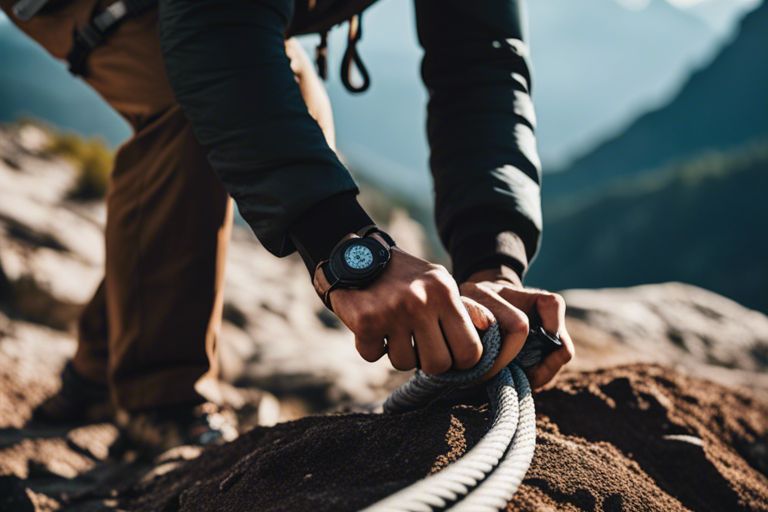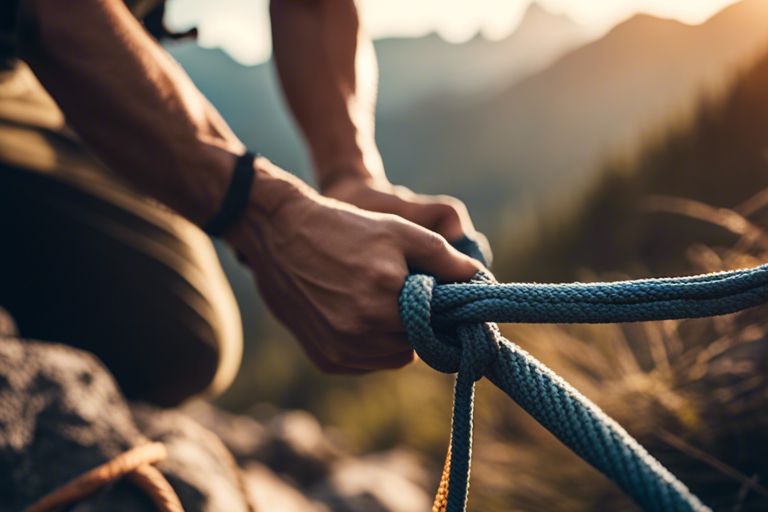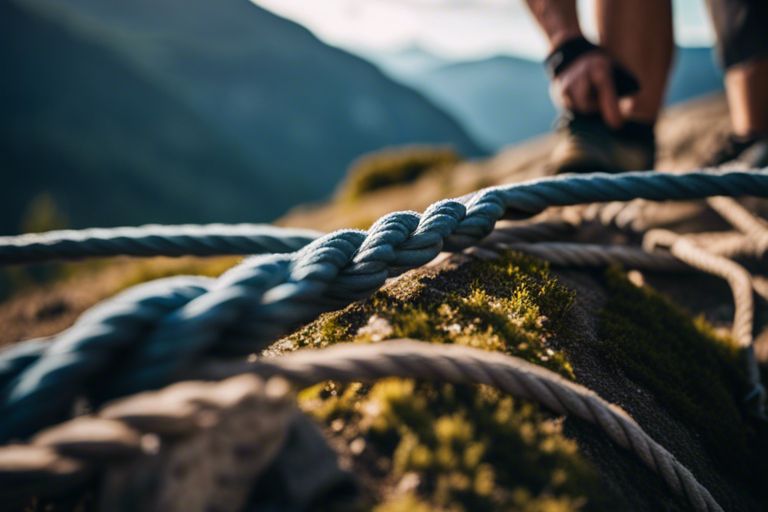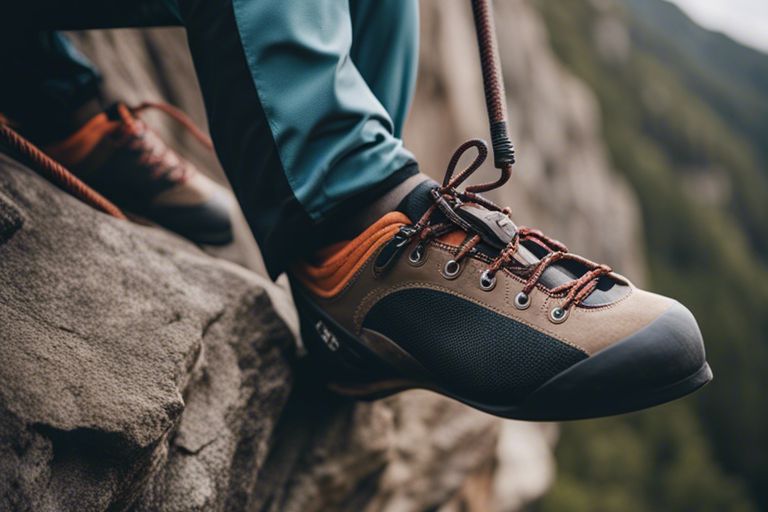Many climbers struggle with knowing how to properly coil their climbing rope, leading to tangles and frustrations when out on the rock. In this guide, you will learn the step-by-step process of coiling your climbing rope to ensure it stays neat, organized, and tangle-free for your next outdoor adventure. By following these simple instructions, you’ll be able to pack up your rope quickly and efficiently, ready to hit the crag with ease.
Key Takeaways:
- Keep the Rope Untangled: Ensuring your climbing rope is free of tangles before coiling will make the process smoother and prevent future knots.
- Use the Butterfly Coil Method: This method involves making large loops to create a coil that can easily be carried or stored without tangling.
- Secure the Coiled Rope Properly: Use a rope strap or tie a figure-eight knot to secure the coiled rope, preventing it from unraveling during transport or storage.

Understanding Your Climbing Rope
A climbing rope is a critical piece of equipment that ensures your safety while climbing. Before you start coiling your climbing rope, it’s important to understand the different factors that come into play when choosing a climbing rope.
Factors to Consider When Choosing a Climbing Rope
- Diameter: The diameter of the rope affects its weight, durability, and handling. Thicker ropes are more durable but heavier, while thinner ropes are lighter but may wear out faster.
- Length: The length of the rope should be suitable for the type of climbing you intend to do, whether it’s single pitch or multi-pitch.
- Dynamic vs Static: Dynamic ropes stretch to absorb the impact of a fall, while static ropes are used for rappelling and hauling gear.
- Treatment: Some ropes come with treatments like dry coating to repel water, reducing the risk of the rope becoming heavier during wet conditions.
This knowledge will help you make an informed decision when selecting a climbing rope that best suits your climbing style and needs.
Types of Climbing Ropes and Their Coiling Requirements
- Single Ropes: These are designed for general climbing purposes and are the most common type of rope used. Single ropes are required to be coiled in a standard butterfly coil for easy handling and storage.
- Twin Ropes: Twin ropes are used in pairs and offer a higher safety margin, ideal for alpine climbing. They should be coiled separately to prevent tangling and ensure equal wear.
While coiling your climbing rope, it’s crucial to follow the specific coiling requirements based on the type of rope you have. Proper coiling not only extends the life of your rope but also makes it easier to handle during climbs.
| Types of Ropes | Coiling Requirements |
|---|---|
| Single Ropes | Standard butterfly coil |
| Twin Ropes | Coiled separately |
The type of climbing rope you own will determine how it should be coiled and stored. By understanding these requirements, you can ensure your rope remains in good condition for your next climbing adventure.
Preparing to Coil Your Climbing Rope
One necessary step before coiling your climbing rope is to make sure it is clean and in good condition. This includes measuring and cutting your rope to the right length, as well as cleaning and inspecting it before coiling.
Tips for Measuring and Cutting Your Rope to the Right Length
Clearly, before you begin coiling your climbing rope, you need to determine the right length for your coils. One way to do this is to measure the rope against your arm from your armpit to your fingertips, and then multiply that length by 3. This should give you a good estimate for the ideal length of your coils.
- Measure the rope against your arm from armpit to fingertips
- Multiply the length by 3 for the ideal coil length
Any excess rope can be trimmed off, but it’s important to have enough length for tying off the coil securely.
How to Clean and Inspect Your Rope Before Coiling
Preparing your climbing rope for coiling involves cleaning and inspecting it to ensure it is safe to use. Lengthwise, lay out the rope and visually inspect it for any signs of wear, such as fraying or cuts. Run your hands along the entire length of the rope to feel for any soft spots, which could indicate damage to the core fibers. It’s important to check the entire length of the rope thoroughly to make sure it is safe for climbing.
Coiling Techniques for Climbing Ropes
Despite being a simple task, coiling a climbing rope properly is crucial for your safety and the longevity of your gear. There are various coiling techniques climbers use, each with its own advantages and disadvantages. In this chapter, we will explore some of the most common coiling methods and guide you through the steps to master them.
The Butterfly Coil Method: A Step-by-Step Guide
To coil your climbing rope using the Butterfly Coil method, follow these simple steps:
| Step 1: | Find the midpoint of the rope. |
| Step 2: | Create two equal loops on each arm. |
| Step 3: | Stack the loops on top of each other, making sure they do not tangle. |
| Step 4: | Tie the two ends of the rope together with a simple overhand knot. |
The Mountain Coil Method: Pros and Cons
An efficient coiling method for longer routes, the Mountain Coil has its own set of pros and cons:
| Pros | Cons |
| Takes less time to uncoil | Prone to twists and tangles |
| Works well for rappelling | Can be bulky to carry |
An efficient coiling method for longer routes, the Mountain Coil has its own set of pros and cons.
The Quick Coil Method: A Fast and Easy Option
The Quick Coil method is perfect for fast transitions between climbs. Here’s how to do it:
When you need to quickly coil your rope for the next climb, the Quick Coil method is a fast and easy option. Simply gather the rope in your hands and make large loops, repeating until the entire length is coiled. This method is not as tidy as others but is great for times when speed is vital.

Mastering the Art of Coiling
Now, let’s research into the intricacies of coiling climbing ropes. To ensure your rope remains tangle-free and easy to manage, mastering the art of coiling is crucial. Proper coiling not only extends the life of your rope but also saves you time and effort when you’re ready to climb.
Tips for Coiling Ropes of Different Diameters and Materials
Twists, kinks, and tangles in your climbing rope can be frustrating. To manage these effectively, it’s crucial to coil your rope neatly and evenly. When dealing with twists, lay the rope straight and then work systematically to remove any kinks. Additionally, rotating the rope in your hands as you coil it can help prevent twists from forming in the first place.
Tips for Coiling Ropes of Different Diameters and Materials
The key to successfully coiling ropes of different diameters and materials lies in understanding their unique characteristics. For thinner ropes, such as those used for sport climbing, a tighter coil will help prevent tangles. On the other hand, thicker ropes, common in traditional climbing, may require a looser coil to avoid unnecessary strain. Knowing the specifics of each rope you work with will ensure optimal coiling every time.
- When coiling a thin rope, create tighter loops for better organization.
- With thicker ropes, opt for a looser coil to maintain the integrity of the material.
- Knowing the nuances of each rope will help you coil efficiently and keep your gear in top condition.
Common Mistakes to Avoid When Coiling Your Climbing Rope
Coiling your climbing rope incorrectly can lead to knots, weak spots, and overall damage. Avoiding common mistakes during the coiling process is crucial in maintaining the integrity and longevity of your rope. Taking the time to coil your rope correctly will save you headaches in the long run and ensure your safety while climbing.
Coiling your climbing rope in a rushed or haphazard manner can result in frustrating tangles that may compromise your safety. Always take the extra time to coil your rope neatly, as this simple step can make a significant difference in how smoothly your climbing outings go.
Rope management is an crucial skill for any climber, and mastering the art of coiling is a fundamental aspect of this. By coiling your climbing rope correctly, you’ll not only prolong its lifespan but also enhance your overall climbing experience. Be mindful of, a well-coiled rope is a safe and reliable one, so take the time to perfect your technique.
Storing and Transporting Your Coiled Climbing Rope
Once again, as a climber, properly storing and transporting your coiled climbing rope is crucial to ensuring its longevity and safety for future climbs. Here are some important guidelines to follow.
How to Properly Store Your Coiled Rope to Prevent Damage
For proper storage of your coiled climbing rope, it’s crucial to keep it in a cool, dry place away from direct sunlight and moisture. Make sure to avoid storing your rope in areas where it can be exposed to chemicals or sharp objects that could cause damage. To prevent twists and tangles, use a rope bag or a dedicated rope tarp to coil and store your rope neatly when not in use.
Tips for Transporting Your Coiled Rope on Climbing Expeditions
An important tip for transporting your coiled climbing rope on expeditions is to use a rope bag with a tarp or a backpack specifically designed for carrying climbing gear. This will help protect your rope from dirt, moisture, and abrasion while making it easier to carry during approaches. Additionally, make sure to keep your rope away from sharp objects and avoid dragging it on rough surfaces to prevent unnecessary wear and tear.
- Always check your rope for any signs of wear or damage before and after each climb.
- Securely tie or pack your coiled rope to your gear to prevent it from getting tangled or caught on obstacles during the approach.
- Properly flake out your rope before climbs to avoid kinks and tangles while leading or belaying.
Plus, when transporting your coiled climbing rope, consider investing in a rope bag with a built-in tarp for added protection during transportation and storage. This will help keep your rope clean, dry, and tangle-free, allowing you to focus on your climb without worrying about the condition of your gear.
Advanced Coiling Techniques for Specific Climbing Disciplines
For this chapter, you will learn advanced coiling techniques tailored for specific climbing disciplines. Whether you are rock climbing, ice climbing, or mountaineering, understanding the unique considerations and specialized techniques for each discipline will help you coil your climbing rope more efficiently and effectively.
Coiling Ropes for Rock Climbing: Unique Considerations
Advanced techniques for coiling ropes for rock climbing involve considerations such as the terrain you will be climbing on and the movements you will be making. When coiling your rope for rock climbing, ensure that your coils are tight and compact to prevent snagging on rocks or getting caught as you move up the wall. Additionally, consider the length of rope you will need for your climb and coil accordingly to avoid excess rope dragging behind you.
| Tip: Make sure to flake the rope before coiling to prevent tangles. | Tip: Practice coiling your rope in different ways to find what works best for you and the type of climbing you do. |
Coiling Ropes for Ice Climbing: Specialized Techniques
Ropes used for ice climbing require specialized coiling techniques due to the cold and icy conditions you will encounter. When coiling your rope for ice climbing, you’ll want to avoid any knots or kinks that could become frozen and difficult to manage. Be sure to coil your rope in a way that allows you to easily feed it out as you climb, even with gloves on, to maintain a smooth and efficient ascent.
Understanding the unique challenges of ice climbing will help you master the specialized techniques needed for coiling your rope effectively. Practice coiling your rope in a controlled environment before tackling icy conditions to ensure you are comfortable and proficient in your technique.
Coiling Ropes for Mountaineering: Long-Distance Hauling
Even when mountaineering, coiling your rope properly is crucial for long-distance hauling and traversing rugged terrain. Advanced coiling techniques for mountaineering involve coiling your rope in a way that allows for easy transportation and deployment as you navigate varied landscapes. Consider using a backpack or rope bag to carry your coiled rope securely and access it quickly when needed.
Specialized techniques for coiling ropes in mountaineering may involve using different rope management systems, such as butterfly coils, to facilitate smooth movement and prevent tangles. Practice these techniques in different scenarios to become proficient in managing your rope effectively during long-distance hauls in challenging mountain environments.
Final Words
On the whole, coiling your climbing rope properly is a crucial skill to ensure its longevity and your safety while climbing. By following the steps outlined in this guide, you can effectively coil your rope to prevent tangles and knots, making it easier to manage during your climbs. Remember to always pay attention to the details, such as aligning the coils neatly and securing the coil with a finishing knot. Properly coiling your climbing rope will not only prolong its life but also make your climbing experiences more enjoyable and stress-free.
Q: How to coil climbing rope?
A: To coil climbing rope, start by flaking the rope on the ground in a straight line. Next, grab the end of the rope and make a small loop, then continue making loops in the same direction until you reach the end of the rope. Finally, secure the coil with a rubber band or rope tie to keep it neat and tidy.
Q: Why is it important to coil climbing rope properly?
A: Coiling climbing rope properly helps to prevent tangles and knots when you’re ready to use it. It also prolongs the lifespan of the rope by reducing wear and tear that can occur from improper storage. Additionally, a neatly coiled rope is easier to carry and transport for your climbing adventures.
Q: How should I store coiled climbing rope?
A: Store coiled climbing rope in a cool, dry place away from direct sunlight and chemicals that could degrade the rope fibers. You can hang the coiled rope on a rope hook or peg, or place it in a rope bag for added protection. Be sure to inspect the rope regularly for any signs of damage or wear, and replace it as needed to ensure safety during climbing.




